Public Health Evaluation Plan: Tuberculosis Prevention in Australia
VerifiedAdded on 2020/05/04
|17
|3598
|167
Report
AI Summary
This report provides a comprehensive public health evaluation plan focusing on tuberculosis (TB) prevention within the Australian population. The report begins with an introduction highlighting the significance of public health and the need for effective TB prevention strategies, followed by a background on the prevalence of TB in Australia, including statistics and risk factors. It then describes a program aimed at early identification, treatment of active TB cases, and contact tracing. The core of the report includes a detailed evaluation plan, outlining goals, objectives, strategies, process and outcome indicators, and data collection methods. The rationale behind the evaluation plan is justified, considering factors like feasibility, stakeholder support, and the importance of health education. The report also discusses strategies for successful dissemination and utilization of the evaluation findings, emphasizing the use of various dissemination tools. The report concludes by summarizing the key findings and recommendations for improving TB prevention efforts in Australia.
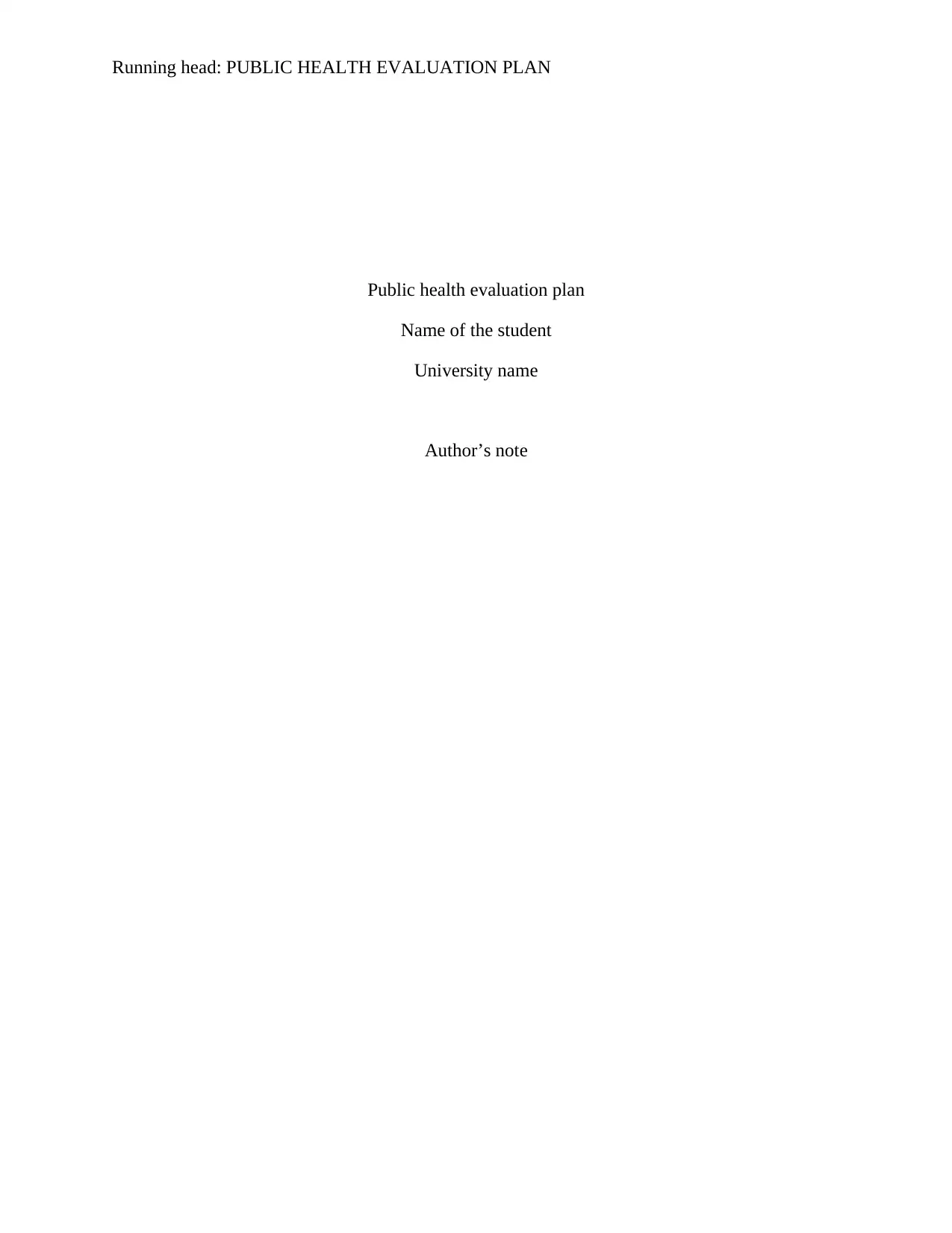
Running head: PUBLIC HEALTH EVALUATION PLAN
Public health evaluation plan
Name of the student
University name
Author’s note
Public health evaluation plan
Name of the student
University name
Author’s note
Paraphrase This Document
Need a fresh take? Get an instant paraphrase of this document with our AI Paraphraser
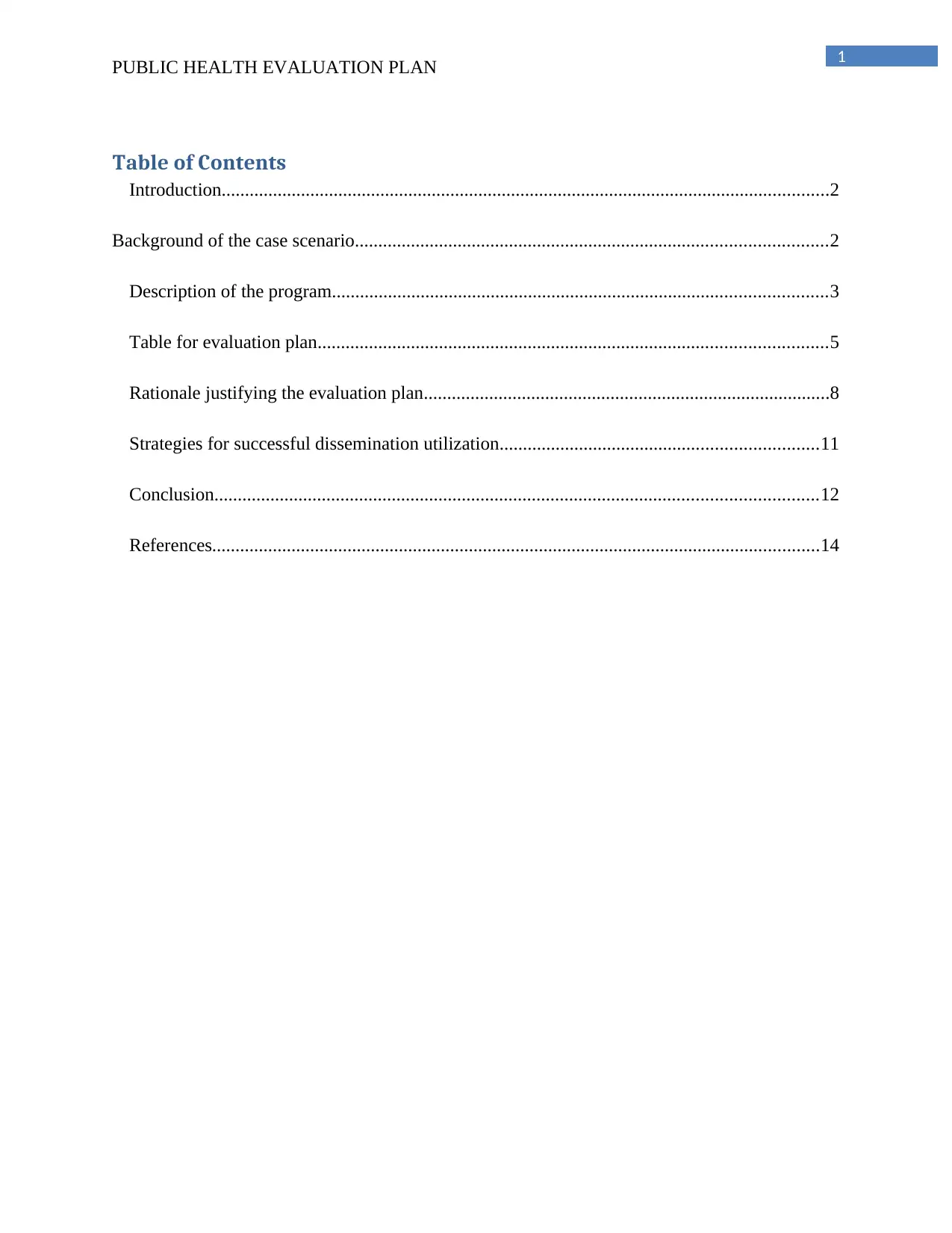
1
PUBLIC HEALTH EVALUATION PLAN
Table of Contents
Introduction..................................................................................................................................2
Background of the case scenario.....................................................................................................2
Description of the program..........................................................................................................3
Table for evaluation plan.............................................................................................................5
Rationale justifying the evaluation plan.......................................................................................8
Strategies for successful dissemination utilization....................................................................11
Conclusion.................................................................................................................................12
References..................................................................................................................................14
PUBLIC HEALTH EVALUATION PLAN
Table of Contents
Introduction..................................................................................................................................2
Background of the case scenario.....................................................................................................2
Description of the program..........................................................................................................3
Table for evaluation plan.............................................................................................................5
Rationale justifying the evaluation plan.......................................................................................8
Strategies for successful dissemination utilization....................................................................11
Conclusion.................................................................................................................................12
References..................................................................................................................................14
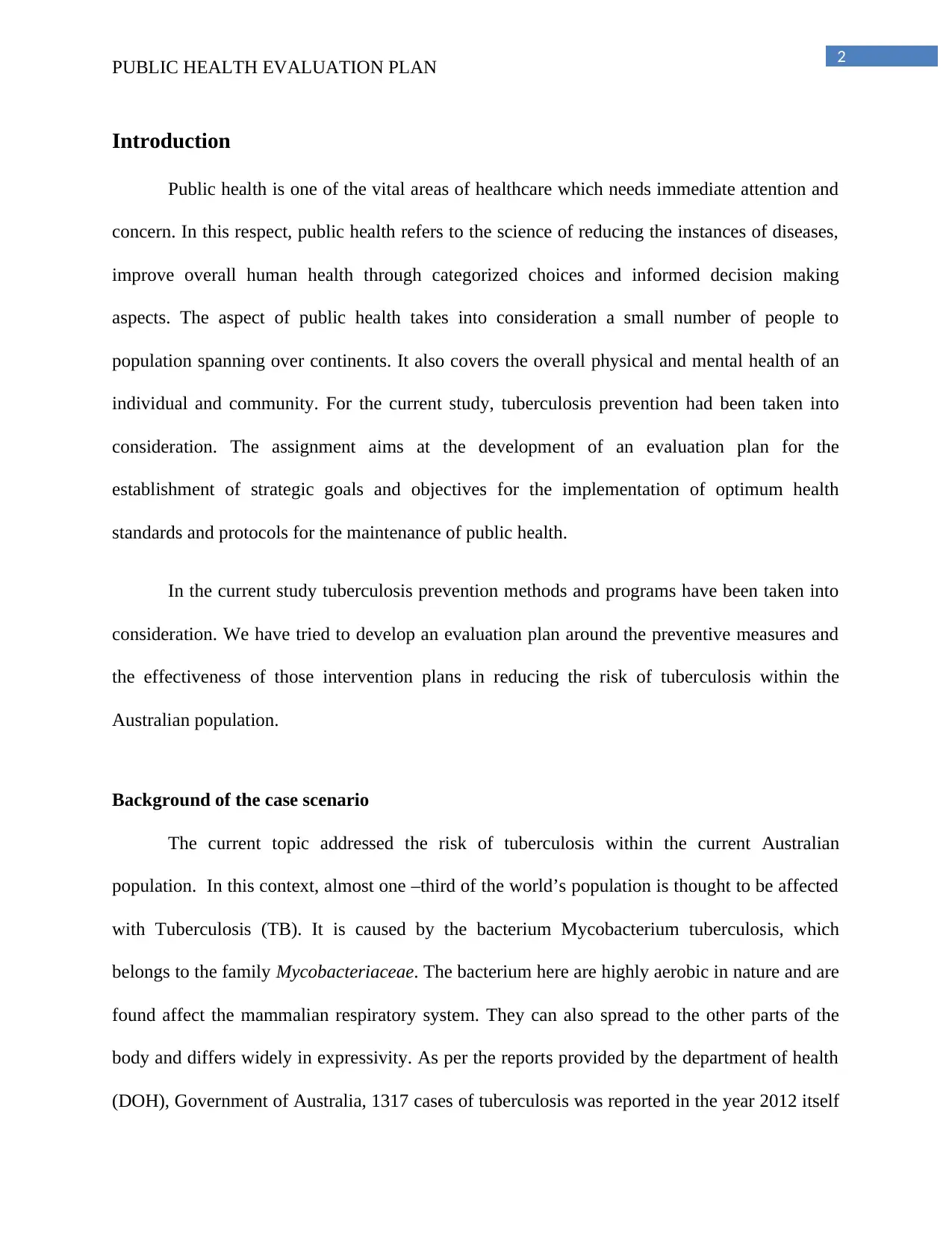
2
PUBLIC HEALTH EVALUATION PLAN
Introduction
Public health is one of the vital areas of healthcare which needs immediate attention and
concern. In this respect, public health refers to the science of reducing the instances of diseases,
improve overall human health through categorized choices and informed decision making
aspects. The aspect of public health takes into consideration a small number of people to
population spanning over continents. It also covers the overall physical and mental health of an
individual and community. For the current study, tuberculosis prevention had been taken into
consideration. The assignment aims at the development of an evaluation plan for the
establishment of strategic goals and objectives for the implementation of optimum health
standards and protocols for the maintenance of public health.
In the current study tuberculosis prevention methods and programs have been taken into
consideration. We have tried to develop an evaluation plan around the preventive measures and
the effectiveness of those intervention plans in reducing the risk of tuberculosis within the
Australian population.
Background of the case scenario
The current topic addressed the risk of tuberculosis within the current Australian
population. In this context, almost one –third of the world’s population is thought to be affected
with Tuberculosis (TB). It is caused by the bacterium Mycobacterium tuberculosis, which
belongs to the family Mycobacteriaceae. The bacterium here are highly aerobic in nature and are
found affect the mammalian respiratory system. They can also spread to the other parts of the
body and differs widely in expressivity. As per the reports provided by the department of health
(DOH), Government of Australia, 1317 cases of tuberculosis was reported in the year 2012 itself
PUBLIC HEALTH EVALUATION PLAN
Introduction
Public health is one of the vital areas of healthcare which needs immediate attention and
concern. In this respect, public health refers to the science of reducing the instances of diseases,
improve overall human health through categorized choices and informed decision making
aspects. The aspect of public health takes into consideration a small number of people to
population spanning over continents. It also covers the overall physical and mental health of an
individual and community. For the current study, tuberculosis prevention had been taken into
consideration. The assignment aims at the development of an evaluation plan for the
establishment of strategic goals and objectives for the implementation of optimum health
standards and protocols for the maintenance of public health.
In the current study tuberculosis prevention methods and programs have been taken into
consideration. We have tried to develop an evaluation plan around the preventive measures and
the effectiveness of those intervention plans in reducing the risk of tuberculosis within the
Australian population.
Background of the case scenario
The current topic addressed the risk of tuberculosis within the current Australian
population. In this context, almost one –third of the world’s population is thought to be affected
with Tuberculosis (TB). It is caused by the bacterium Mycobacterium tuberculosis, which
belongs to the family Mycobacteriaceae. The bacterium here are highly aerobic in nature and are
found affect the mammalian respiratory system. They can also spread to the other parts of the
body and differs widely in expressivity. As per the reports provided by the department of health
(DOH), Government of Australia, 1317 cases of tuberculosis was reported in the year 2012 itself
⊘ This is a preview!⊘
Do you want full access?
Subscribe today to unlock all pages.

Trusted by 1+ million students worldwide
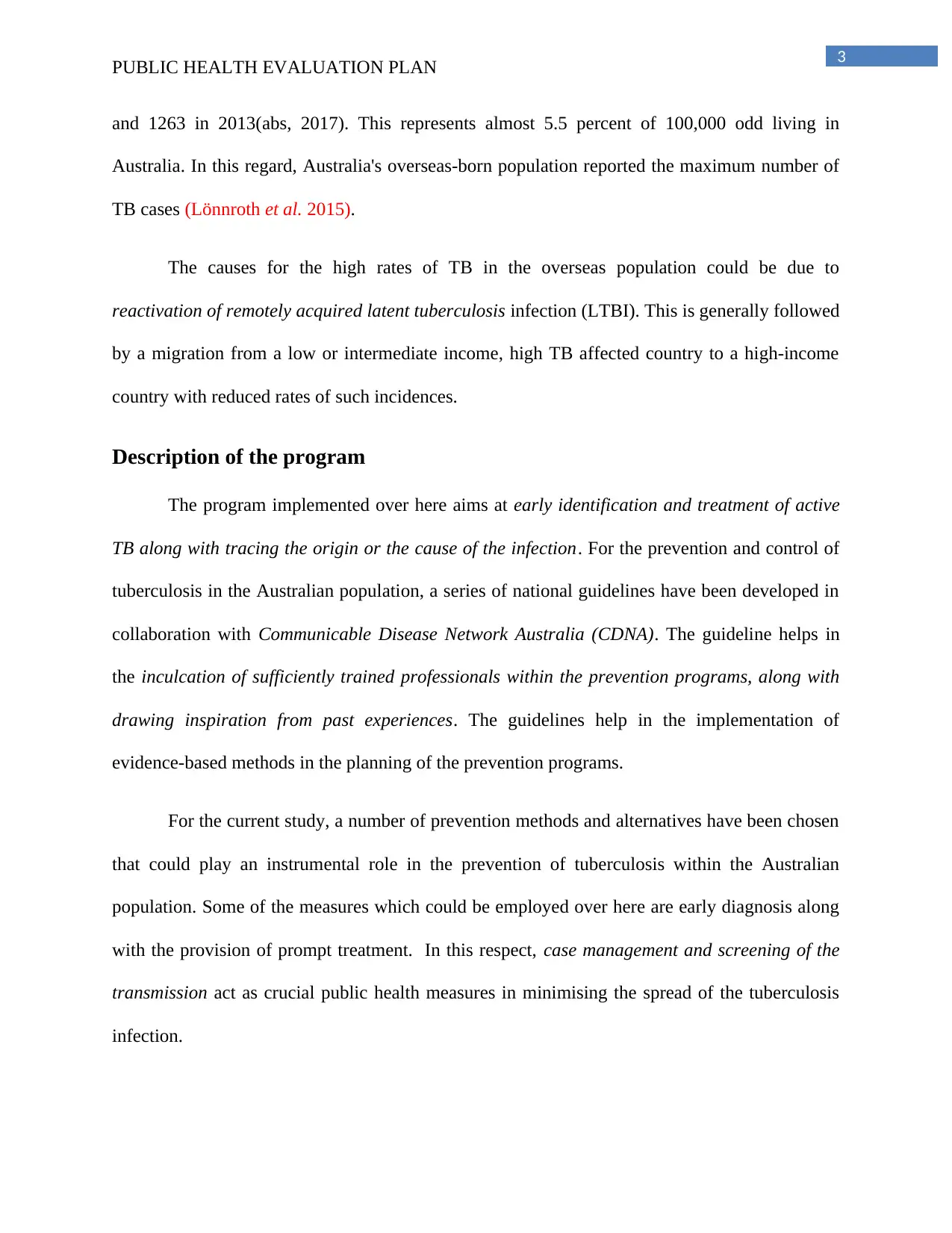
3
PUBLIC HEALTH EVALUATION PLAN
and 1263 in 2013(abs, 2017). This represents almost 5.5 percent of 100,000 odd living in
Australia. In this regard, Australia's overseas-born population reported the maximum number of
TB cases (Lönnroth et al. 2015).
The causes for the high rates of TB in the overseas population could be due to
reactivation of remotely acquired latent tuberculosis infection (LTBI). This is generally followed
by a migration from a low or intermediate income, high TB affected country to a high-income
country with reduced rates of such incidences.
Description of the program
The program implemented over here aims at early identification and treatment of active
TB along with tracing the origin or the cause of the infection. For the prevention and control of
tuberculosis in the Australian population, a series of national guidelines have been developed in
collaboration with Communicable Disease Network Australia (CDNA). The guideline helps in
the inculcation of sufficiently trained professionals within the prevention programs, along with
drawing inspiration from past experiences. The guidelines help in the implementation of
evidence-based methods in the planning of the prevention programs.
For the current study, a number of prevention methods and alternatives have been chosen
that could play an instrumental role in the prevention of tuberculosis within the Australian
population. Some of the measures which could be employed over here are early diagnosis along
with the provision of prompt treatment. In this respect, case management and screening of the
transmission act as crucial public health measures in minimising the spread of the tuberculosis
infection.
PUBLIC HEALTH EVALUATION PLAN
and 1263 in 2013(abs, 2017). This represents almost 5.5 percent of 100,000 odd living in
Australia. In this regard, Australia's overseas-born population reported the maximum number of
TB cases (Lönnroth et al. 2015).
The causes for the high rates of TB in the overseas population could be due to
reactivation of remotely acquired latent tuberculosis infection (LTBI). This is generally followed
by a migration from a low or intermediate income, high TB affected country to a high-income
country with reduced rates of such incidences.
Description of the program
The program implemented over here aims at early identification and treatment of active
TB along with tracing the origin or the cause of the infection. For the prevention and control of
tuberculosis in the Australian population, a series of national guidelines have been developed in
collaboration with Communicable Disease Network Australia (CDNA). The guideline helps in
the inculcation of sufficiently trained professionals within the prevention programs, along with
drawing inspiration from past experiences. The guidelines help in the implementation of
evidence-based methods in the planning of the prevention programs.
For the current study, a number of prevention methods and alternatives have been chosen
that could play an instrumental role in the prevention of tuberculosis within the Australian
population. Some of the measures which could be employed over here are early diagnosis along
with the provision of prompt treatment. In this respect, case management and screening of the
transmission act as crucial public health measures in minimising the spread of the tuberculosis
infection.
Paraphrase This Document
Need a fresh take? Get an instant paraphrase of this document with our AI Paraphraser
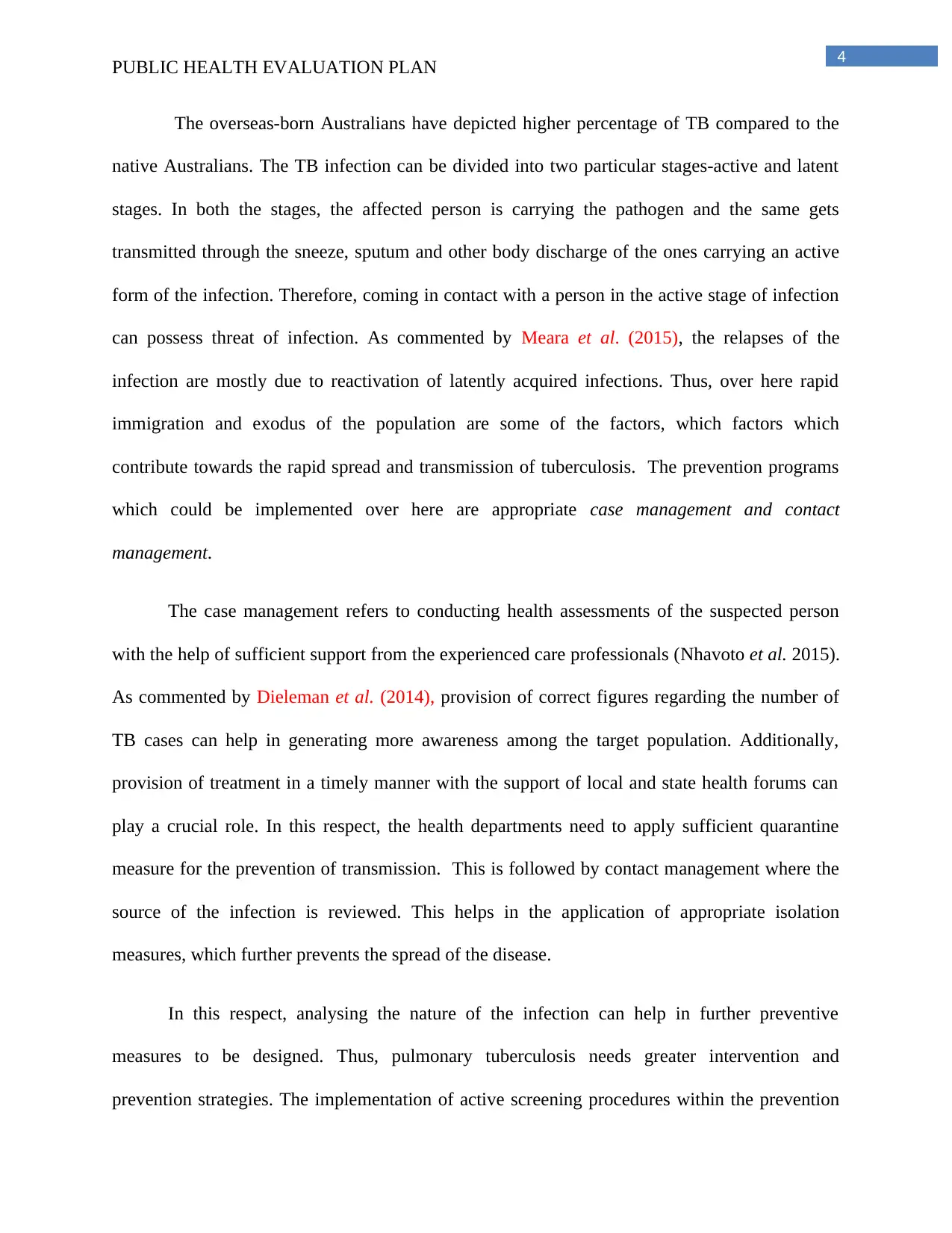
4
PUBLIC HEALTH EVALUATION PLAN
The overseas-born Australians have depicted higher percentage of TB compared to the
native Australians. The TB infection can be divided into two particular stages-active and latent
stages. In both the stages, the affected person is carrying the pathogen and the same gets
transmitted through the sneeze, sputum and other body discharge of the ones carrying an active
form of the infection. Therefore, coming in contact with a person in the active stage of infection
can possess threat of infection. As commented by Meara et al. (2015), the relapses of the
infection are mostly due to reactivation of latently acquired infections. Thus, over here rapid
immigration and exodus of the population are some of the factors, which factors which
contribute towards the rapid spread and transmission of tuberculosis. The prevention programs
which could be implemented over here are appropriate case management and contact
management.
The case management refers to conducting health assessments of the suspected person
with the help of sufficient support from the experienced care professionals (Nhavoto et al. 2015).
As commented by Dieleman et al. (2014), provision of correct figures regarding the number of
TB cases can help in generating more awareness among the target population. Additionally,
provision of treatment in a timely manner with the support of local and state health forums can
play a crucial role. In this respect, the health departments need to apply sufficient quarantine
measure for the prevention of transmission. This is followed by contact management where the
source of the infection is reviewed. This helps in the application of appropriate isolation
measures, which further prevents the spread of the disease.
In this respect, analysing the nature of the infection can help in further preventive
measures to be designed. Thus, pulmonary tuberculosis needs greater intervention and
prevention strategies. The implementation of active screening procedures within the prevention
PUBLIC HEALTH EVALUATION PLAN
The overseas-born Australians have depicted higher percentage of TB compared to the
native Australians. The TB infection can be divided into two particular stages-active and latent
stages. In both the stages, the affected person is carrying the pathogen and the same gets
transmitted through the sneeze, sputum and other body discharge of the ones carrying an active
form of the infection. Therefore, coming in contact with a person in the active stage of infection
can possess threat of infection. As commented by Meara et al. (2015), the relapses of the
infection are mostly due to reactivation of latently acquired infections. Thus, over here rapid
immigration and exodus of the population are some of the factors, which factors which
contribute towards the rapid spread and transmission of tuberculosis. The prevention programs
which could be implemented over here are appropriate case management and contact
management.
The case management refers to conducting health assessments of the suspected person
with the help of sufficient support from the experienced care professionals (Nhavoto et al. 2015).
As commented by Dieleman et al. (2014), provision of correct figures regarding the number of
TB cases can help in generating more awareness among the target population. Additionally,
provision of treatment in a timely manner with the support of local and state health forums can
play a crucial role. In this respect, the health departments need to apply sufficient quarantine
measure for the prevention of transmission. This is followed by contact management where the
source of the infection is reviewed. This helps in the application of appropriate isolation
measures, which further prevents the spread of the disease.
In this respect, analysing the nature of the infection can help in further preventive
measures to be designed. Thus, pulmonary tuberculosis needs greater intervention and
prevention strategies. The implementation of active screening procedures within the prevention
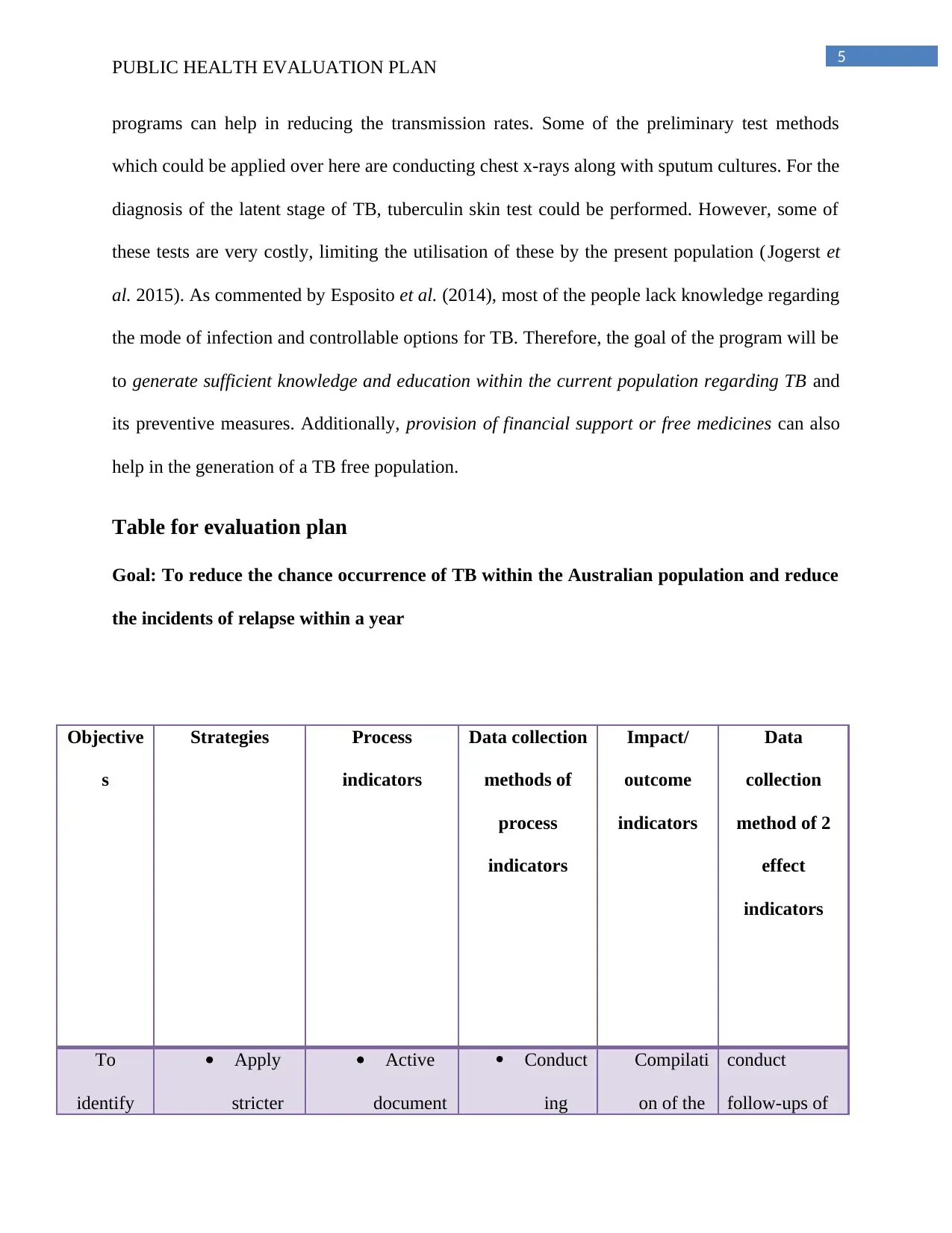
5
PUBLIC HEALTH EVALUATION PLAN
programs can help in reducing the transmission rates. Some of the preliminary test methods
which could be applied over here are conducting chest x-rays along with sputum cultures. For the
diagnosis of the latent stage of TB, tuberculin skin test could be performed. However, some of
these tests are very costly, limiting the utilisation of these by the present population (Jogerst et
al. 2015). As commented by Esposito et al. (2014), most of the people lack knowledge regarding
the mode of infection and controllable options for TB. Therefore, the goal of the program will be
to generate sufficient knowledge and education within the current population regarding TB and
its preventive measures. Additionally, provision of financial support or free medicines can also
help in the generation of a TB free population.
Table for evaluation plan
Goal: To reduce the chance occurrence of TB within the Australian population and reduce
the incidents of relapse within a year
Objective
s
Strategies Process
indicators
Data collection
methods of
process
indicators
Impact/
outcome
indicators
Data
collection
method of 2
effect
indicators
To
identify
Apply
stricter
Active
document
Conduct
ing
Compilati
on of the
conduct
follow-ups of
PUBLIC HEALTH EVALUATION PLAN
programs can help in reducing the transmission rates. Some of the preliminary test methods
which could be applied over here are conducting chest x-rays along with sputum cultures. For the
diagnosis of the latent stage of TB, tuberculin skin test could be performed. However, some of
these tests are very costly, limiting the utilisation of these by the present population (Jogerst et
al. 2015). As commented by Esposito et al. (2014), most of the people lack knowledge regarding
the mode of infection and controllable options for TB. Therefore, the goal of the program will be
to generate sufficient knowledge and education within the current population regarding TB and
its preventive measures. Additionally, provision of financial support or free medicines can also
help in the generation of a TB free population.
Table for evaluation plan
Goal: To reduce the chance occurrence of TB within the Australian population and reduce
the incidents of relapse within a year
Objective
s
Strategies Process
indicators
Data collection
methods of
process
indicators
Impact/
outcome
indicators
Data
collection
method of 2
effect
indicators
To
identify
Apply
stricter
Active
document
Conduct
ing
Compilati
on of the
conduct
follow-ups of
⊘ This is a preview!⊘
Do you want full access?
Subscribe today to unlock all pages.

Trusted by 1+ million students worldwide
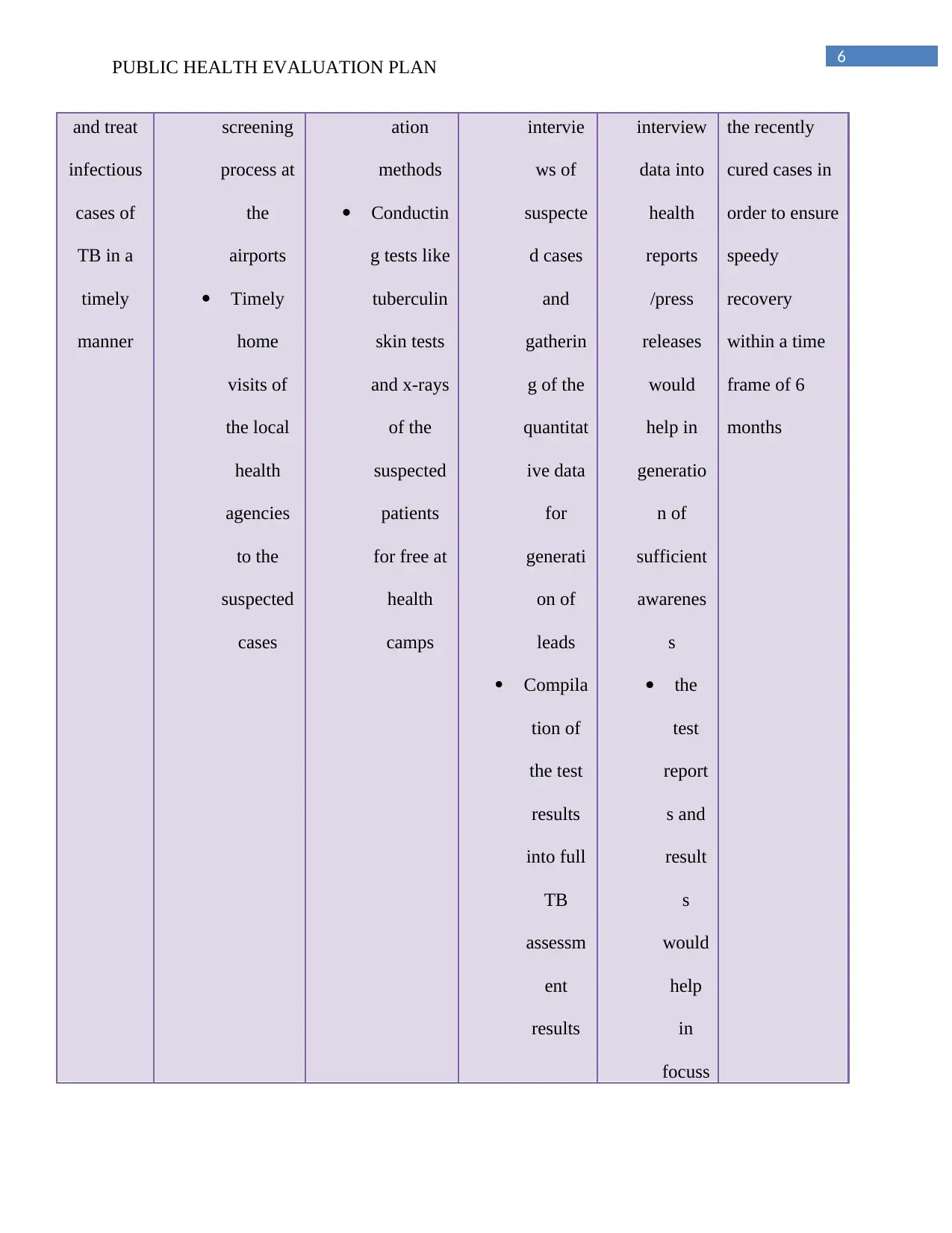
6
PUBLIC HEALTH EVALUATION PLAN
and treat
infectious
cases of
TB in a
timely
manner
screening
process at
the
airports
Timely
home
visits of
the local
health
agencies
to the
suspected
cases
ation
methods
Conductin
g tests like
tuberculin
skin tests
and x-rays
of the
suspected
patients
for free at
health
camps
intervie
ws of
suspecte
d cases
and
gatherin
g of the
quantitat
ive data
for
generati
on of
leads
Compila
tion of
the test
results
into full
TB
assessm
ent
results
interview
data into
health
reports
/press
releases
would
help in
generatio
n of
sufficient
awarenes
s
the
test
report
s and
result
s
would
help
in
focuss
the recently
cured cases in
order to ensure
speedy
recovery
within a time
frame of 6
months
PUBLIC HEALTH EVALUATION PLAN
and treat
infectious
cases of
TB in a
timely
manner
screening
process at
the
airports
Timely
home
visits of
the local
health
agencies
to the
suspected
cases
ation
methods
Conductin
g tests like
tuberculin
skin tests
and x-rays
of the
suspected
patients
for free at
health
camps
intervie
ws of
suspecte
d cases
and
gatherin
g of the
quantitat
ive data
for
generati
on of
leads
Compila
tion of
the test
results
into full
TB
assessm
ent
results
interview
data into
health
reports
/press
releases
would
help in
generatio
n of
sufficient
awarenes
s
the
test
report
s and
result
s
would
help
in
focuss
the recently
cured cases in
order to ensure
speedy
recovery
within a time
frame of 6
months
Paraphrase This Document
Need a fresh take? Get an instant paraphrase of this document with our AI Paraphraser
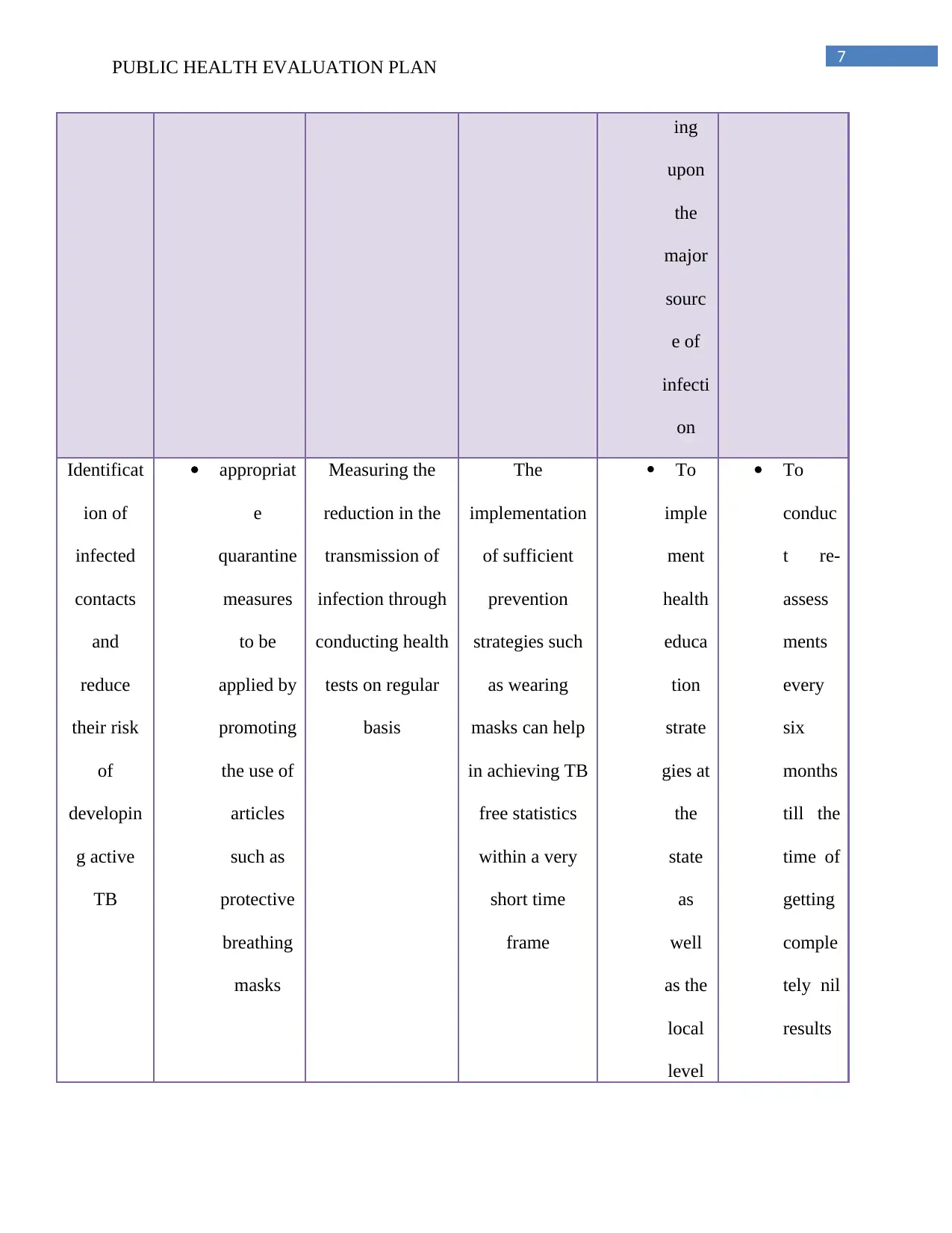
7
PUBLIC HEALTH EVALUATION PLAN
ing
upon
the
major
sourc
e of
infecti
on
Identificat
ion of
infected
contacts
and
reduce
their risk
of
developin
g active
TB
appropriat
e
quarantine
measures
to be
applied by
promoting
the use of
articles
such as
protective
breathing
masks
Measuring the
reduction in the
transmission of
infection through
conducting health
tests on regular
basis
The
implementation
of sufficient
prevention
strategies such
as wearing
masks can help
in achieving TB
free statistics
within a very
short time
frame
To
imple
ment
health
educa
tion
strate
gies at
the
state
as
well
as the
local
level
To
conduc
t re-
assess
ments
every
six
months
till the
time of
getting
comple
tely nil
results
PUBLIC HEALTH EVALUATION PLAN
ing
upon
the
major
sourc
e of
infecti
on
Identificat
ion of
infected
contacts
and
reduce
their risk
of
developin
g active
TB
appropriat
e
quarantine
measures
to be
applied by
promoting
the use of
articles
such as
protective
breathing
masks
Measuring the
reduction in the
transmission of
infection through
conducting health
tests on regular
basis
The
implementation
of sufficient
prevention
strategies such
as wearing
masks can help
in achieving TB
free statistics
within a very
short time
frame
To
imple
ment
health
educa
tion
strate
gies at
the
state
as
well
as the
local
level
To
conduc
t re-
assess
ments
every
six
months
till the
time of
getting
comple
tely nil
results
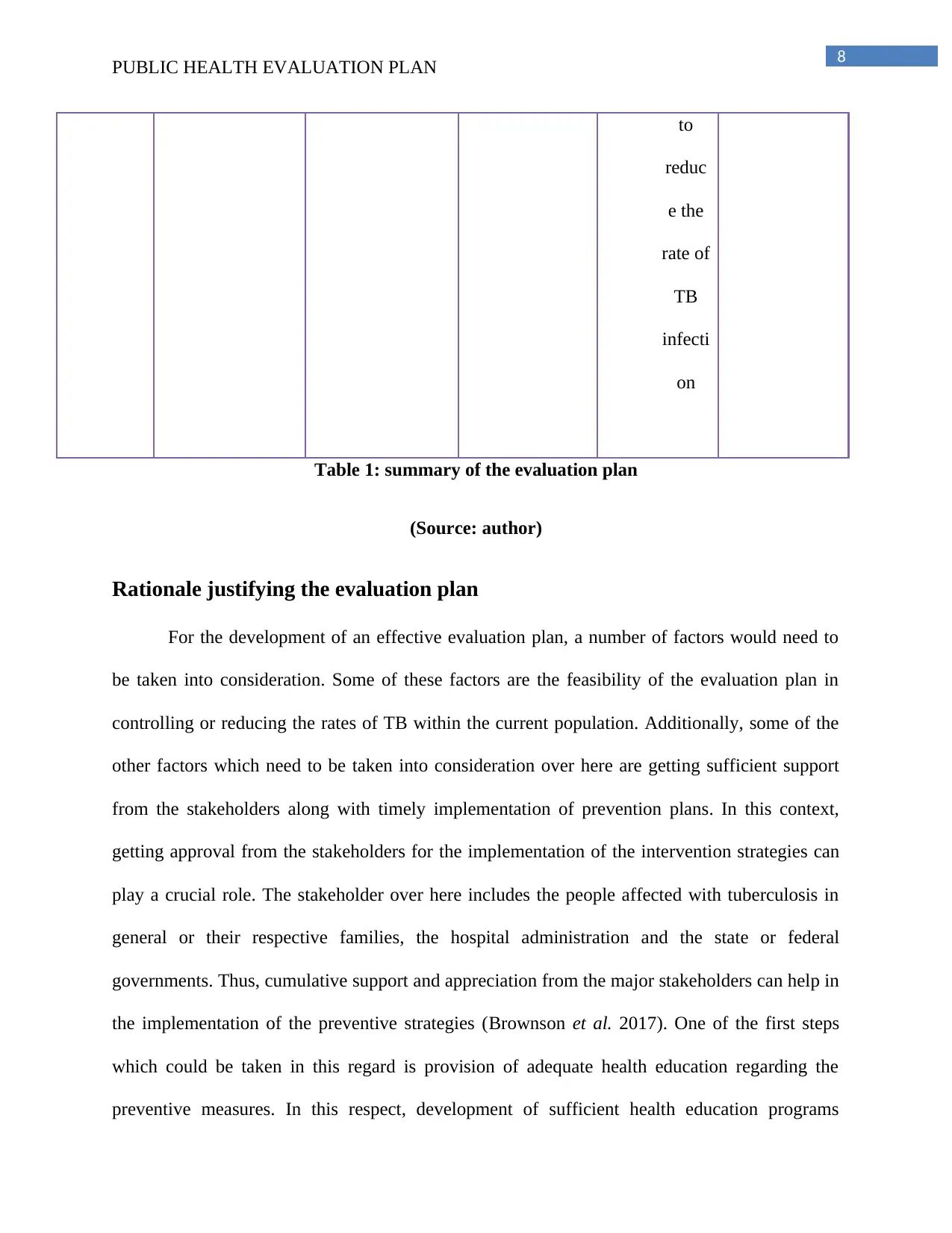
8
PUBLIC HEALTH EVALUATION PLAN
to
reduc
e the
rate of
TB
infecti
on
Table 1: summary of the evaluation plan
(Source: author)
Rationale justifying the evaluation plan
For the development of an effective evaluation plan, a number of factors would need to
be taken into consideration. Some of these factors are the feasibility of the evaluation plan in
controlling or reducing the rates of TB within the current population. Additionally, some of the
other factors which need to be taken into consideration over here are getting sufficient support
from the stakeholders along with timely implementation of prevention plans. In this context,
getting approval from the stakeholders for the implementation of the intervention strategies can
play a crucial role. The stakeholder over here includes the people affected with tuberculosis in
general or their respective families, the hospital administration and the state or federal
governments. Thus, cumulative support and appreciation from the major stakeholders can help in
the implementation of the preventive strategies (Brownson et al. 2017). One of the first steps
which could be taken in this regard is provision of adequate health education regarding the
preventive measures. In this respect, development of sufficient health education programs
PUBLIC HEALTH EVALUATION PLAN
to
reduc
e the
rate of
TB
infecti
on
Table 1: summary of the evaluation plan
(Source: author)
Rationale justifying the evaluation plan
For the development of an effective evaluation plan, a number of factors would need to
be taken into consideration. Some of these factors are the feasibility of the evaluation plan in
controlling or reducing the rates of TB within the current population. Additionally, some of the
other factors which need to be taken into consideration over here are getting sufficient support
from the stakeholders along with timely implementation of prevention plans. In this context,
getting approval from the stakeholders for the implementation of the intervention strategies can
play a crucial role. The stakeholder over here includes the people affected with tuberculosis in
general or their respective families, the hospital administration and the state or federal
governments. Thus, cumulative support and appreciation from the major stakeholders can help in
the implementation of the preventive strategies (Brownson et al. 2017). One of the first steps
which could be taken in this regard is provision of adequate health education regarding the
preventive measures. In this respect, development of sufficient health education programs
⊘ This is a preview!⊘
Do you want full access?
Subscribe today to unlock all pages.

Trusted by 1+ million students worldwide
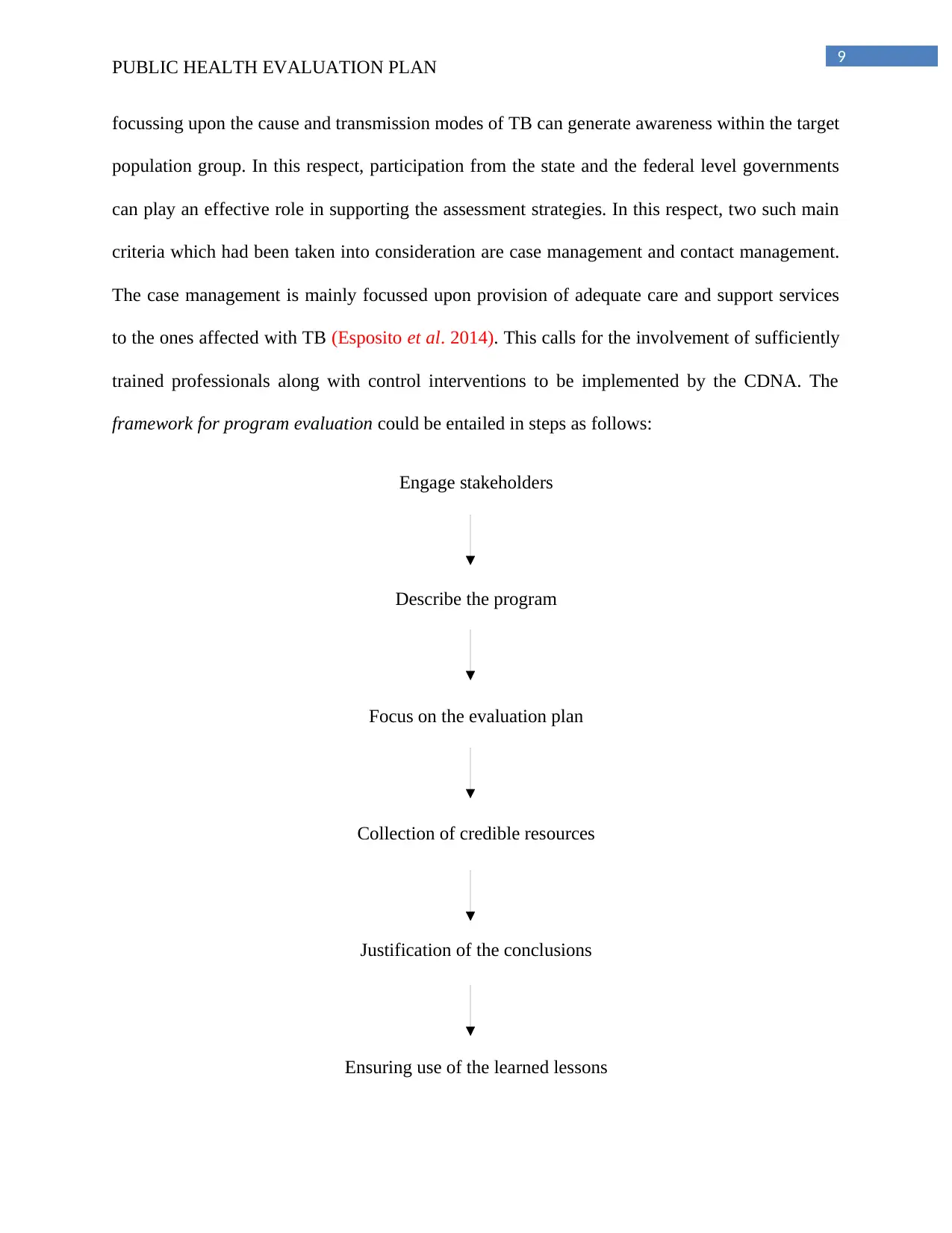
9
PUBLIC HEALTH EVALUATION PLAN
focussing upon the cause and transmission modes of TB can generate awareness within the target
population group. In this respect, participation from the state and the federal level governments
can play an effective role in supporting the assessment strategies. In this respect, two such main
criteria which had been taken into consideration are case management and contact management.
The case management is mainly focussed upon provision of adequate care and support services
to the ones affected with TB (Esposito et al. 2014). This calls for the involvement of sufficiently
trained professionals along with control interventions to be implemented by the CDNA. The
framework for program evaluation could be entailed in steps as follows:
Engage stakeholders
Describe the program
Focus on the evaluation plan
Collection of credible resources
Justification of the conclusions
Ensuring use of the learned lessons
PUBLIC HEALTH EVALUATION PLAN
focussing upon the cause and transmission modes of TB can generate awareness within the target
population group. In this respect, participation from the state and the federal level governments
can play an effective role in supporting the assessment strategies. In this respect, two such main
criteria which had been taken into consideration are case management and contact management.
The case management is mainly focussed upon provision of adequate care and support services
to the ones affected with TB (Esposito et al. 2014). This calls for the involvement of sufficiently
trained professionals along with control interventions to be implemented by the CDNA. The
framework for program evaluation could be entailed in steps as follows:
Engage stakeholders
Describe the program
Focus on the evaluation plan
Collection of credible resources
Justification of the conclusions
Ensuring use of the learned lessons
Paraphrase This Document
Need a fresh take? Get an instant paraphrase of this document with our AI Paraphraser
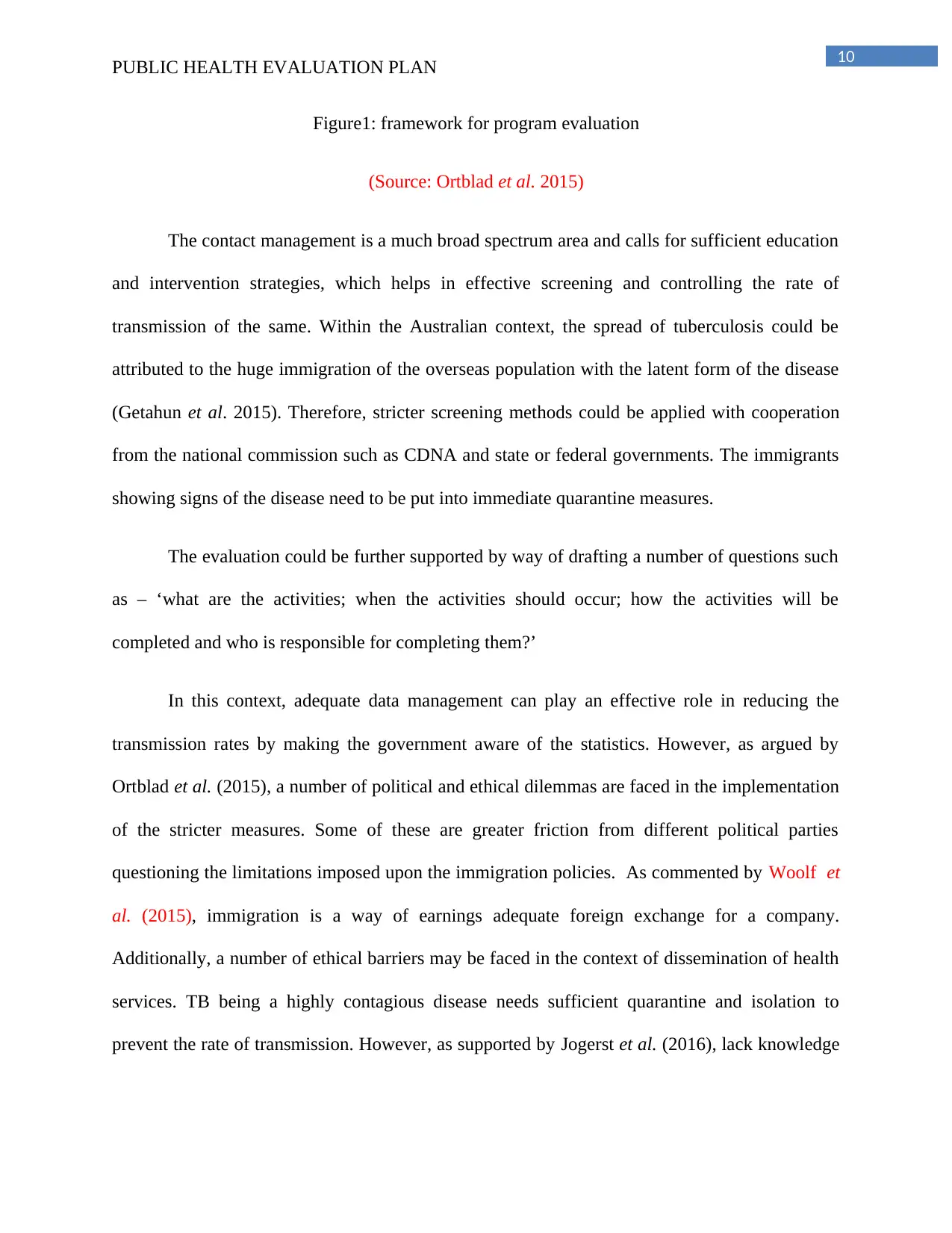
10
PUBLIC HEALTH EVALUATION PLAN
Figure1: framework for program evaluation
(Source: Ortblad et al. 2015)
The contact management is a much broad spectrum area and calls for sufficient education
and intervention strategies, which helps in effective screening and controlling the rate of
transmission of the same. Within the Australian context, the spread of tuberculosis could be
attributed to the huge immigration of the overseas population with the latent form of the disease
(Getahun et al. 2015). Therefore, stricter screening methods could be applied with cooperation
from the national commission such as CDNA and state or federal governments. The immigrants
showing signs of the disease need to be put into immediate quarantine measures.
The evaluation could be further supported by way of drafting a number of questions such
as – ‘what are the activities; when the activities should occur; how the activities will be
completed and who is responsible for completing them?’
In this context, adequate data management can play an effective role in reducing the
transmission rates by making the government aware of the statistics. However, as argued by
Ortblad et al. (2015), a number of political and ethical dilemmas are faced in the implementation
of the stricter measures. Some of these are greater friction from different political parties
questioning the limitations imposed upon the immigration policies. As commented by Woolf et
al. (2015), immigration is a way of earnings adequate foreign exchange for a company.
Additionally, a number of ethical barriers may be faced in the context of dissemination of health
services. TB being a highly contagious disease needs sufficient quarantine and isolation to
prevent the rate of transmission. However, as supported by Jogerst et al. (2016), lack knowledge
PUBLIC HEALTH EVALUATION PLAN
Figure1: framework for program evaluation
(Source: Ortblad et al. 2015)
The contact management is a much broad spectrum area and calls for sufficient education
and intervention strategies, which helps in effective screening and controlling the rate of
transmission of the same. Within the Australian context, the spread of tuberculosis could be
attributed to the huge immigration of the overseas population with the latent form of the disease
(Getahun et al. 2015). Therefore, stricter screening methods could be applied with cooperation
from the national commission such as CDNA and state or federal governments. The immigrants
showing signs of the disease need to be put into immediate quarantine measures.
The evaluation could be further supported by way of drafting a number of questions such
as – ‘what are the activities; when the activities should occur; how the activities will be
completed and who is responsible for completing them?’
In this context, adequate data management can play an effective role in reducing the
transmission rates by making the government aware of the statistics. However, as argued by
Ortblad et al. (2015), a number of political and ethical dilemmas are faced in the implementation
of the stricter measures. Some of these are greater friction from different political parties
questioning the limitations imposed upon the immigration policies. As commented by Woolf et
al. (2015), immigration is a way of earnings adequate foreign exchange for a company.
Additionally, a number of ethical barriers may be faced in the context of dissemination of health
services. TB being a highly contagious disease needs sufficient quarantine and isolation to
prevent the rate of transmission. However, as supported by Jogerst et al. (2016), lack knowledge
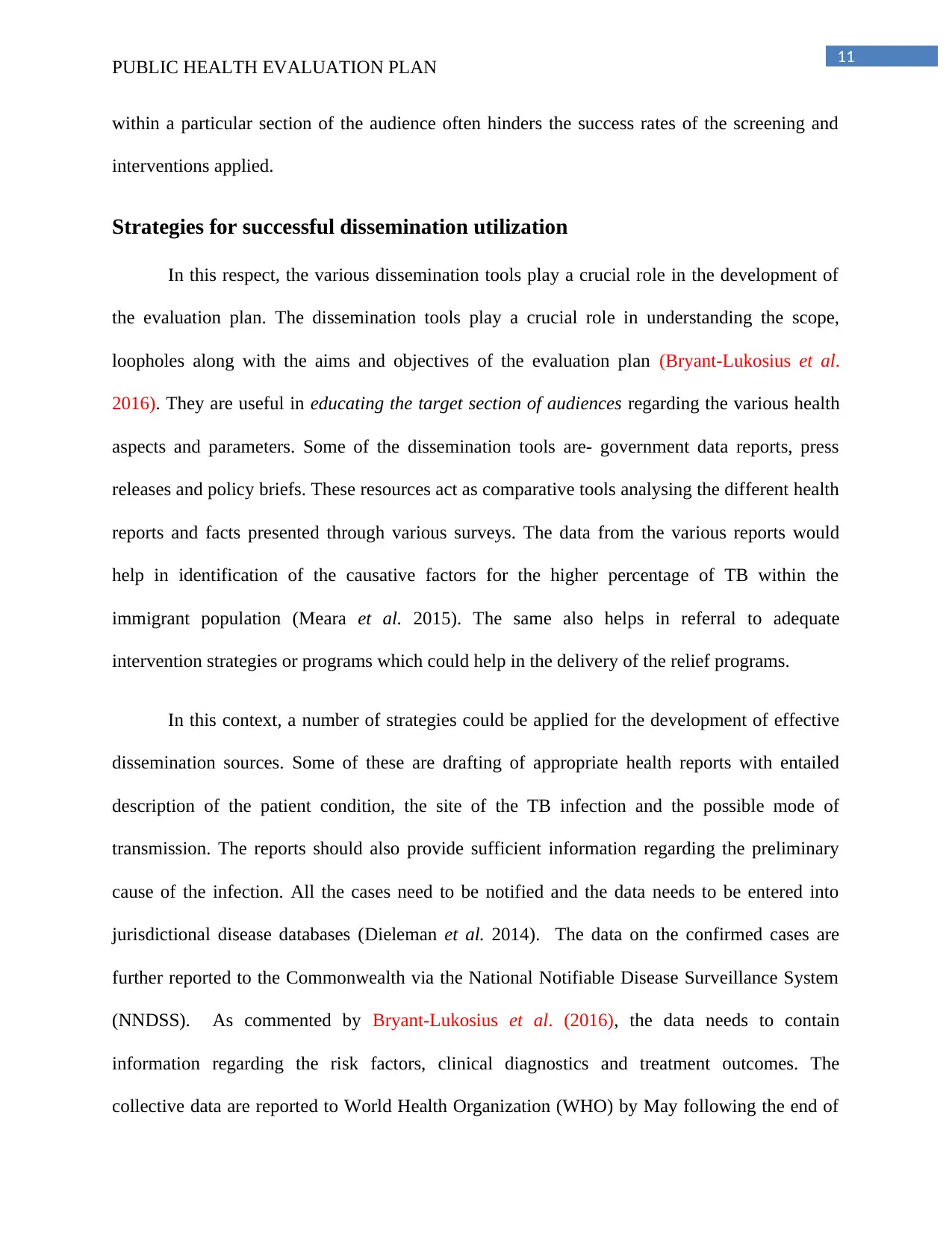
11
PUBLIC HEALTH EVALUATION PLAN
within a particular section of the audience often hinders the success rates of the screening and
interventions applied.
Strategies for successful dissemination utilization
In this respect, the various dissemination tools play a crucial role in the development of
the evaluation plan. The dissemination tools play a crucial role in understanding the scope,
loopholes along with the aims and objectives of the evaluation plan (Bryant‐Lukosius et al.
2016). They are useful in educating the target section of audiences regarding the various health
aspects and parameters. Some of the dissemination tools are- government data reports, press
releases and policy briefs. These resources act as comparative tools analysing the different health
reports and facts presented through various surveys. The data from the various reports would
help in identification of the causative factors for the higher percentage of TB within the
immigrant population (Meara et al. 2015). The same also helps in referral to adequate
intervention strategies or programs which could help in the delivery of the relief programs.
In this context, a number of strategies could be applied for the development of effective
dissemination sources. Some of these are drafting of appropriate health reports with entailed
description of the patient condition, the site of the TB infection and the possible mode of
transmission. The reports should also provide sufficient information regarding the preliminary
cause of the infection. All the cases need to be notified and the data needs to be entered into
jurisdictional disease databases (Dieleman et al. 2014). The data on the confirmed cases are
further reported to the Commonwealth via the National Notifiable Disease Surveillance System
(NNDSS). As commented by Bryant‐Lukosius et al. (2016), the data needs to contain
information regarding the risk factors, clinical diagnostics and treatment outcomes. The
collective data are reported to World Health Organization (WHO) by May following the end of
PUBLIC HEALTH EVALUATION PLAN
within a particular section of the audience often hinders the success rates of the screening and
interventions applied.
Strategies for successful dissemination utilization
In this respect, the various dissemination tools play a crucial role in the development of
the evaluation plan. The dissemination tools play a crucial role in understanding the scope,
loopholes along with the aims and objectives of the evaluation plan (Bryant‐Lukosius et al.
2016). They are useful in educating the target section of audiences regarding the various health
aspects and parameters. Some of the dissemination tools are- government data reports, press
releases and policy briefs. These resources act as comparative tools analysing the different health
reports and facts presented through various surveys. The data from the various reports would
help in identification of the causative factors for the higher percentage of TB within the
immigrant population (Meara et al. 2015). The same also helps in referral to adequate
intervention strategies or programs which could help in the delivery of the relief programs.
In this context, a number of strategies could be applied for the development of effective
dissemination sources. Some of these are drafting of appropriate health reports with entailed
description of the patient condition, the site of the TB infection and the possible mode of
transmission. The reports should also provide sufficient information regarding the preliminary
cause of the infection. All the cases need to be notified and the data needs to be entered into
jurisdictional disease databases (Dieleman et al. 2014). The data on the confirmed cases are
further reported to the Commonwealth via the National Notifiable Disease Surveillance System
(NNDSS). As commented by Bryant‐Lukosius et al. (2016), the data needs to contain
information regarding the risk factors, clinical diagnostics and treatment outcomes. The
collective data are reported to World Health Organization (WHO) by May following the end of
⊘ This is a preview!⊘
Do you want full access?
Subscribe today to unlock all pages.

Trusted by 1+ million students worldwide
1 out of 17
Related Documents
Your All-in-One AI-Powered Toolkit for Academic Success.
+13062052269
info@desklib.com
Available 24*7 on WhatsApp / Email
![[object Object]](/_next/static/media/star-bottom.7253800d.svg)
Unlock your academic potential
Copyright © 2020–2025 A2Z Services. All Rights Reserved. Developed and managed by ZUCOL.





